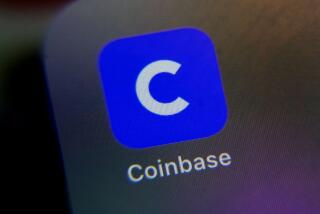Nasdaq settles Facebook IPO debacle with SEC
- Share via
NEW YORK — Nasdaq OMX Group will pay $10 million for botching Facebook’s initial public stock offering last year, a debacle that shook investors’ confidence in Wall Street.
Nasdaq’s penalty would be the biggest ever paid by an exchange, said the Securities and Exchange Commission, which faulted the firm’s “poor systems and decision-making” during one of the most-watched IPOs of all time. Nasdaq’s systems had a design flaw that failed to properly match orders to buy and sell Facebook shares on their May 18, 2012, public debut, causing havoc in how the stock traded.
The SEC, which announced the enforcement action and Nasdaq’s settlement Wednesday, faulted Nasdaq for a series of ill-fated decisions and for violating its own rules. Facebook’s marred IPO shook retail investors’ confidence in Wall Street and called into question the ability of financial firms to control increasingly computerized stock trading.
“The penalty is designed to teach Nasdaq a lesson,” said Anthony Sabino, an expert in securities law at St. John’s University.
“While Nasdaq and the NYSE are private enterprises, the burden they carry for their near monopoly in running the stock market is they have to make sure it is fair and efficient,” Sabino added. “When they make a blunder it clogs up the market.”
The day before Facebook’s IPO, the exchange tested its computer systems on 40,000 trades, the SEC said. But the high volume of orders — nearly 500,000 when trading officially began — overwhelmed its programs, delaying trading confirmations and sparking investor confusion.
Despite the breakdown, Nasdaq’s senior leadership held a “code blue” conference call that day and decided not to delay the trading of Facebook shares on the open stock market, the SEC said. The stock exchange fixed a “few lines of computer code” but “did not understand the root cause of the problem,” the agency said.
The result: More than 30,000 Facebook orders were stuck in Nasdaq’s system for more than two hours, when they should have been immediately executed or canceled, the SEC said.
The SEC’s “action against Nasdaq tells the tale of how poorly designed systems and hasty decision-making not only disrupted one of the largest IPOs in history, but produced serious and pervasive violations of fundamental rules governing our markets,” George Canellos, the agency’s co-director of enforcement, said in a statement.
The problem was magnified as shares of the stock plunged after opening higher than expected. The failures also spilled over into the trading of Zynga shares, and the exchange failed to properly execute 365 orders of that stock, the SEC said.
Wall Street firms lost as much as $500 million because of glitches that day.
Nasdaq’s violations of its own rules stemmed from a more than 3-million-share short position in — or bet against — Facebook stock in an “unauthorized error account.” Nasdaq wound up making a $10.8-million profit from the position, the SEC said.
In an open letter issued Wednesday, Nasdaq Chief Executive Robert Greifeld said the exchange has put extra safeguards in place.
“While we prepared extensively for the Facebook initial public offering, including through tests of our systems with member firms, the challenges we encountered that day were unprecedented,” Greifeld said.
Besides the SEC penalty, Nasdaq is also potentially facing further legal action from investors. Swiss banking giant UBS, for one, tallied its glitch-related losses at $357 million and plans to recoup money through arbitration. Nasdaq agreed in March to shell out $62 million to repay brokerages that lost money during the debacle.
The Facebook fiasco was just one of several technical snafus in recent years that have sparked fears about computerized trading run amok.
Trading firm Knight Capital Group, for example, lost $440 million last year after a botched software upgrade triggered inadvertent trades. In a so-called flash crash in May 2010, about $1 trillion temporarily vanished from the stock market after trading went haywire.
Daniel Hawke, chief of the SEC Enforcement Division’s market abuse unit, said many market disruptions nowadays are too easily dismissed as “mere technical glitches.”
“Our focus in this investigation was on the design limitations of Nasdaq’s system and the exchange’s decision-making after that limitation came to light,” Hawke wrote in a statement.
Experts say the penalty will teach Nasdaq and the New York Stock Exchange to use more caution going forward. But even caution won’t prevent more bumps in stock markets that increasingly rely on computers for super-fast trades.
“The bottom line is that in the world, changes in technology rapidly accelerate the flow of information and trades,” said Sabino, the law professor. “It’s like driving a car too fast, too long on a very hot day. You will overheat. Even the best precautions will not prevent some breakdown in the system.”
More to Read
Inside the business of entertainment
The Wide Shot brings you news, analysis and insights on everything from streaming wars to production — and what it all means for the future.
You may occasionally receive promotional content from the Los Angeles Times.











